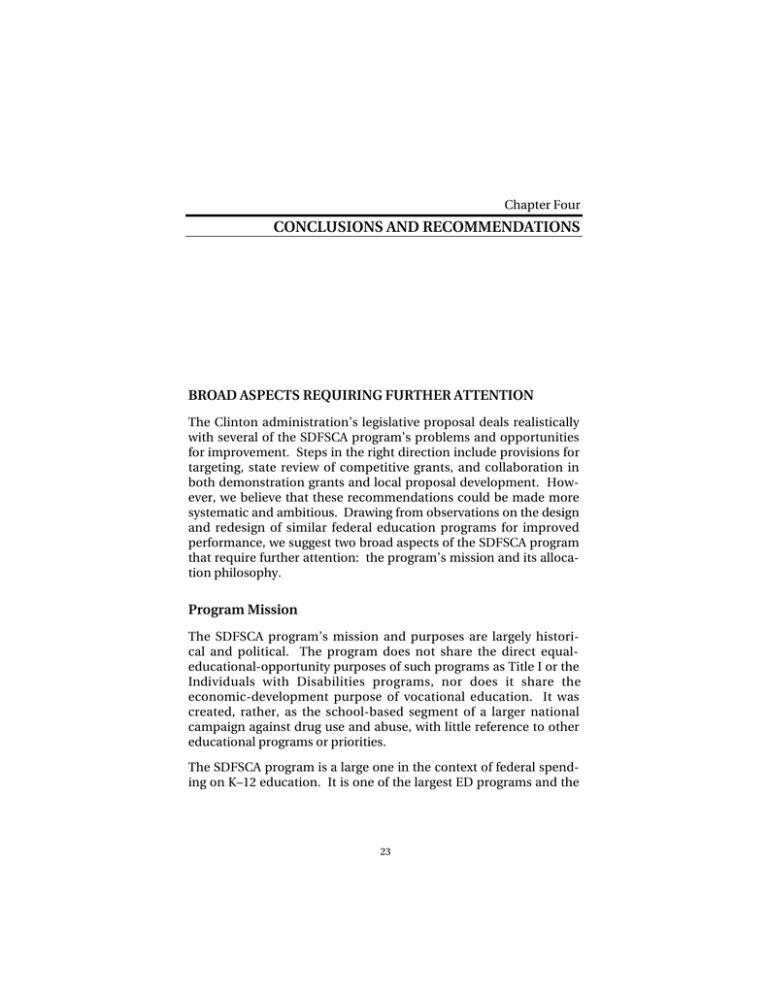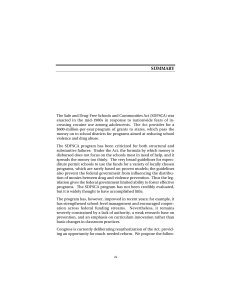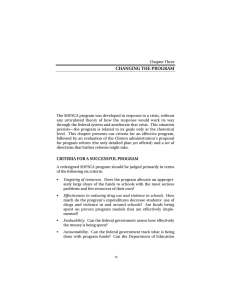CONCLUSIONS AND RECOMMENDATIONS BROAD ASPECTS REQUIRING FURTHER ATTENTION
advertisement

Chapter Four CONCLUSIONS AND RECOMMENDATIONS BROAD ASPECTS REQUIRING FURTHER ATTENTION The Clinton administration’s legislative proposal deals realistically with several of the SDFSCA program’s problems and opportunities for improvement. Steps in the right direction include provisions for targeting, state review of competitive grants, and collaboration in both demonstration grants and local proposal development. However, we believe that these recommendations could be made more systematic and ambitious. Drawing from observations on the design and redesign of similar federal education programs for improved performance, we suggest two broad aspects of the SDFSCA program that require further attention: the program’s mission and its allocation philosophy. Program Mission The SDFSCA program’s mission and purposes are largely historical and political. The program does not share the direct equaleducational-opportunity purposes of such programs as Title I or the Individuals with Disabilities programs, nor does it share the economic-development purpose of vocational education. It was created, rather, as the school-based segment of a larger national campaign against drug use and abuse, with little reference to other educational programs or priorities. The SDFSCA program is a large one in the context of federal spending on K–12 education. It is one of the largest ED programs and the 23 24 Options for Restructuring the SDFSCA largest started since the creation of such major programs as those created by the Elementary and Secondary Education Act (ESEA) and the Individuals with Disabilities Education Act (IDEA). Through a congeries of small categorical programs, the Department provides funding for almost every form of educational activity that occurs in most school districts, but the funding is typically at token levels, intended to provide endorsement and symbolic leadership. At $550 million to $600 million per year, the SDFSCA level of funding transcends symbolism. The program should have specific, measurable objectives for every level of government and the means to ensure that they are being achieved. The program’s political significance should be reflected in the Department’s national leadership (“bully pulpit”) actions. Where the ED has taken emerging national concerns seriously, in such disparate arenas as nationwide standards and assessments, reading improvement, and religious expression in public schools, it has been effective at mobilizing dialogue and highlighting consensus for initiative. The ED could develop such a campaign around themes of drug and violence prevention and thus augment the work of the SDFSCA program. The combination of drug-abuse and violence prevention missions in a single program should also be reconsidered. These two problems are not clearly related in either cause or cure. The assumptions about common antecedents are probably incorrect: Much violence is rooted in family and community problems, independent of drug use or distribution. Moreover, even if drug abuse and violence share common roots or strong connections, the solutions to the two problems may require different approaches. For example, drug use may best be addressed through specific curricula, and violence through classroom climate changes and disciplinary policies. At every level, program managers make decisions about whether to emphasize drug-abuse or violence prevention, resulting in arbitrary patterns of activity and resource allocation. Currently, drug prevention is reported to be losing resources to violence prevention and safety programs in this zero-sum process—not an intended outcome. It is worth considering whether the two purposes should be separated, either within the SDFSCA program or by dropping violence prevention from the program and creating a companion program. Conclusions and Recommendations 25 Allocation Philosophy The problems encountered in the operation of the SDFSCA program are not unique in either the federal government or the ED. Modern federalism is broadly concerned with distributing federal moneys to lower-level government units for the purpose of ensuring that good programs are implemented effectively and that those units most in need of services get the most funding. This ambition has only been made more urgent by the passage of the Government Performance Review Act (GPRA). Most federal programs overlap with other federal programs, and coordination is difficult to achieve. The high cost of evaluation and the weakness of the research base in the prevention field accentuate the difficulty of assuring effective local activities, but these problems are not outside the range of other federal program experience. Other major education programs sharing some of these features have gradually developed adequate allocation mechanisms. For example, the Federal Vocational Education program1 disburses relatively large sums ($1.15 billion in 1999) to improve the workforce skills of young persons entering the labor market.2 Long criticized for an allocation formula that disbursed moneys too broadly and failed to reward performance, the legislation was amended in 1990 to allow for moretargeted expenditures (U.S. Department of Education, 1994). Fewer schools now receive larger sums of money, and the schools that do are more likely to be in poorer districts and to serve students who need and can benefit from vocational education. Small school districts are encouraged to form consortia for purposes of proposal submission. One important lesson from the reform of the Perkins Act is that it is possible to restructure a program that has previously been treated as a school or organizational entitlement. Such restructuring may take time—several reauthorizations and mandated national evaluations ______________ 1 Currently authorized by the Carl D. Perkins Vocational-Technical Education Act Amendments of 1998 (P.L. 105-332). 2 Furthermore, in a notable historical parallel, the 1917 Smith-Hughes Act virtually created the field of vocational education, much as the SDFSCA aspires to create a prevention field. 26 Options for Restructuring the SDFSCA from 1963 to 1994 were required in the case of vocational education—but it can be done, politically and programmatically. RECOMMENDATIONS On the basis of the preceding perspectives and our proposed criteria, we believe the following three alternative avenues for change would each remedy the SDFSCA program’s problems at least as well as the changes proposed by the Clinton administration. These changes seem compatible with the Bush administration’s objectives as well. 1. Change the within-state allocation formula to give much more weight to need and capacity of districts. Districts or consortia of small, low-need districts would apply for state grants. States would pass the funds through to eligible grantees noncompetitively. Grants would meet or exceed a minimum level of dollars per student (or school) to ensure that schools could implement meaningful programs. Not all funded programs would be evaluated, but a sample would periodically be chosen for evaluation. 2. Change the basic character of the program, replacing formula grants to states with direct federal grants. Grants would be given to a much smaller number of school districts, which would serve as models for others in the nation. This approach has been adopted by other federal education programs, such as the program for educational technology and, to a considerable extent, the bilingual education program. The problems of violence and drug use among school children are so pervasive that the approximately $600 million in SDFSCA funds can account for only a small share of the total resources needed. By making the SDFSCA program a demonstration program, Congress would be recognizing the distinctive role and capacity of the federal government in demonstrating models that states and localities could adopt and fund. 3. Create requirements for state and local efforts. The SDFSCA program could offer matching grants, as is done for vocational education, or require a comprehensive state-funded program as a condition for federal contribution, as is done for IDEA. In both of these cases, state and local contributions have secured support for program goals, surpassed the federal contribution several times over, and created nearly universal opportunities for students with needs Conclusions and Recommendations 27 addressed by the programs. Only substantially increased state and local efforts could possibly enable total governmental resources to cover all serious needs. For any of these three alternatives, the federal government must furnish the SDFSCA program with an array of capacity-building authorities. The program should designate funds for research to be carried out through the ED’s Office of Educational Research and Improvement or through other agencies such as the National Institute on Drug Abuse or the National Institute of Justice. The program should also have the authority to make sustained investments in training activities for both new and experienced teachers. Comprehensive national evaluations should be scheduled to provide the federal government with reliable information about program successes and problems, timed to contribute to deliberations concerning reauthorization.3 Finally, considering the lack of communication and coordination among programs and levels of government, the Department should take the lead in regularly convening federal, state, and local officials for the explicit purpose of enhancing collaboration among all related school-based prevention programs, not just those supported by the SDFSCA program. CONCLUDING COMMENT The current SDFSCA program structure is almost universally considered to be profoundly flawed; we are unaware of anyone who will explicitly defend it. However, the problems addressed by the program are so serious and widespread that the federal government cannot reasonably abandon its commitment. Unfortunately, there are few proposals for reform. The Clinton administration’s proposal addresses some but not all of the ways in which the program could be improved. If the SDFSCA program is to survive and flourish, it must become more demonstrably effective at reducing schoolrelated drug use and violence. ______________ 3 The SDFSCA program might be an ideal candidate for experimentation with inter- active, Internet-based schemes for program monitoring and assessment.





